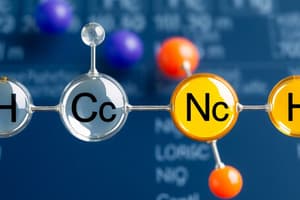Podcast
Questions and Answers
What determines whether a molecule is polar?
What determines whether a molecule is polar?
- The size of the molecule.
- The types of covalent bonds and the shape of the molecule. (correct)
- Only the shape of the molecule.
- Only the types of covalent bonds present.
Atoms covalently bonded are less stable than they were as separate atoms.
Atoms covalently bonded are less stable than they were as separate atoms.
False (B)
What is the term of the attraction between polar molecules?
What is the term of the attraction between polar molecules?
dipole-dipole forces
The intermolecular force resulting from polarity in which a hydrogen atom that is bonded to a highly electronegative atom and thus becomes a positive dipole is attracted to an unshared pair (lone pair) of electrons of an electronegative atoms in a nearby molecule is ______.
The intermolecular force resulting from polarity in which a hydrogen atom that is bonded to a highly electronegative atom and thus becomes a positive dipole is attracted to an unshared pair (lone pair) of electrons of an electronegative atoms in a nearby molecule is ______.
Match the covalent compound name with its prefix:
Match the covalent compound name with its prefix:
Which of the following statements accurately describes valence electrons in covalent bonding?
Which of the following statements accurately describes valence electrons in covalent bonding?
Ionic compounds generally have lower melting and boiling points compared to molecular compounds.
Ionic compounds generally have lower melting and boiling points compared to molecular compounds.
What is the term when atoms of some elements share more than one electron pair?
What is the term when atoms of some elements share more than one electron pair?
If a molecule has three identical polar bonds at 120° from each other, the molecule will be ______.
If a molecule has three identical polar bonds at 120° from each other, the molecule will be ______.
Which statement accurately describes the behavior of valence electrons in covalent bond formation?
Which statement accurately describes the behavior of valence electrons in covalent bond formation?
Flashcards
Covalent Bonding
Covalent Bonding
Atoms bonded together by sharing electrons to form molecules.
Valence Electrons
Valence Electrons
Electrons in the outermost energy level of an atom; involved in chemical bonding.
Covalent Bond
Covalent Bond
The sharing of electrons between atoms.
Lone Pair
Lone Pair
Signup and view all the flashcards
Multiple Bond
Multiple Bond
Signup and view all the flashcards
Electron Sharing Diagram
Electron Sharing Diagram
Signup and view all the flashcards
Electron Deficient
Electron Deficient
Signup and view all the flashcards
Polar Covalent Bond
Polar Covalent Bond
Signup and view all the flashcards
London Dispersion Forces
London Dispersion Forces
Signup and view all the flashcards
Hydrogen Bonding
Hydrogen Bonding
Signup and view all the flashcards
Study Notes
- Atoms bonded covalently yield molecules.
- Molecules are neutral in charge.
- Molecular formulas denote the types and numbers of atoms in a molecule.
- Valence electrons, located in the outermost energy level of an atom, facilitate bonding.
- The nucleus of one atom attracts the valence electrons of another, drawing atoms together.
- A covalent bond forms through the sharing of electrons between atoms.
- Covalent bonds require each atom to have space for an additional electron in its valence shell.
- Atoms bond to achieve a full valence shell, increasing stability.
- Covalently bonded atoms are more stable than separate atoms.
- Two non-metals can share electrons.
- Overlapping outer shells allows electron sharing between atoms.
Naming Binary Covalent Compounds
- Naming conventions for binary covalent compounds:
- 1 = mono
- 2 = di
- 3 = tri
- 4 = tetra
- 5 = penta
- 6 = hexa
- 7 = hepta
- 8 = octa
- 9 = nona
- 10 = deca
- Sulfur Trioxide example: SO3
- Covalent compounds use prefixes, unlike ionic compounds.
- Ionic compounds consist of a metal and a non-metal, while covalent compounds involve two non-metals.
- Unshared electron pairs are called lone pairs, are not involved in bonding, and belong exclusively to one atom.
Multiple Bonds
- Elements like carbon, nitrogen, and oxygen can share multiple electron pairs.
- Double bonds involve the sharing of four electrons between two atoms.
Covalent Bonds:
- Steps to represent covalent bonds for element combinations:
- Draw the dot diagram for each atom.
- Illustrate shared electrons with circles.
- Create the Lewis structure.
- Write the molecular formula.
- Name the compound.
- Example: H + Cl → H-Cl (Hydrogen Monochloride)
Exceptions to the Octet Rule
- Electron Deficient (hypovalent) molecules have less than 8 valence electrons.
- Boron (B) can be stable with 6 valence electrons.
- Beryllium (Be) can be stable with 4 valence electrons.
- Expanded Octet (hypervalency) molecules have more than 8 valence electrons.
- Phosphorus (P) can be stable with 10 valence electrons.
- Sulfur (S) can be stable with 12 valence electrons.
Polar vs Nonpolar Bonds
- Electronegativity difference of 0-0.3 indicates a nonpolar covalent bond where electrons are shared equally.
- Electronegativity difference of 0.3-1.7 indicates a polar covalent bond where electrons are shared unequally.
- Polar covalent bonds are indicated using lowercase delta (δ).
- The less electronegative atom gets a positive delta symbol (δ+).
- The more electronegative atom gets a negative delta symbol (δ-).
- An arrow in a bond diagram points toward the more electronegative element.
Properties of Molecules
- Small molecules are typically gases.
- Molecules are poor conductors of electricity.
- Intramolecular bonds (within molecules) are strong.
- Intermolecular bonds (between molecules) are weak, leading to low melting and boiling points.
- Larger molecules can be liquids or soft solids.
- Ionic compounds generally have higher melting and boiling points compared to molecules.
- Ionic compounds are hard, brittle, and good conductors of electricity.
Molecular Geometry
- VSEPR theory explains molecular geometry through Valence Shell Electron Pair Repulsion.
- Valence electron pairs around covalently bonded atoms repel each other.
- This repulsion leads valence electron pairs to be as far apart as possible, resulting in specific molecular shapes.
- Linear: 180° angle, two atoms bonded to a central atom with no lone pairs.
- Trigonal Planar: 120° angle, three atoms bonded to a central atom with no lone pairs.
- Bent: 109.5° (with 1 lone pair) or 120° (with 2 lone pairs), two atoms bonded to a central atom with lone pair(s).
- Tetrahedral: 109.5° angle, four atoms bonded to a central atom with no lone pairs.
- Trigonal Pyramidal: 109.5° angle, three atoms bonded to a central atom with one lone pair.
Molecular Polarity and Dipole-Dipole Forces
- The strongest intermolecular forces occur between polar molecules.
- Molecular polarity depends on both the type of covalent bonds and the shape of the molecule.
- More electronegative atoms in a polar molecule pull shared electrons more strongly, creating a dipole.
- In liquids or solids, the negative region of one polar molecule attracts the positive region of another.
- This attraction between polar molecules is termed dipole-dipole forces.
Hydrogen Bonding
- Hydrogen bonding is an intermolecular force resulting from polarity.
- It occurs when a hydrogen atom bonded to a highly electronegative atom becomes a positive dipole and is attracted to lone pair electrons on an electronegative atom in a nearby molecule.
- Hydrogen bonding is a special, strong, case of dipole-dipole forces.
London Dispersion Forces
- London dispersion forces are relatively weak intermolecular forces.
- They arise from the constant motion of electrons and the creation of instantaneous dipoles.
- Uneven electron distribution can create a brief dipole within an atom, inducing a dipole in an adjacent atom or molecule.
- All atoms and molecules experience London dispersion forces.
- This force is the only intermolecular force acting among noble gas atoms and nonpolar molecules.
Determining Molecular Polarity:
- The presence of polar bonds doesn't guarantee that a molecule is polar.
- Nonpolar molecules have either nonpolar bonds or polar bonds whose dipoles cancel out.
- Polar molecules have polar bonds with dipoles that do not cancel out.
Why is Water Polar?
- In water, H-O bonds are not balanced around the structure, so the pulls do not cancel.
- Lone pairs on oxygen cause asymmetry (imbalance).
- The electron cloud is shifted such that there is greater negative charge near oxygen and greater positive charge near hydrogen.
Adding Dipole Moments:
- Linear (nonpolar): Two identical polar bonds pointing in opposite directions will cancel each other out.
- Bent (polar): Two polar bonds with an angle of less than 180° between them will not cancel each other out.
- Trigonal Planar (nonpolar): Three identical polar bonds at 120° from each other will cancel.
- Tetrahedral (nonpolar): Four identical polar bonds in a tetrahedral arrangement (109.5°) will cancel.
- Trigonal Pyramidal (polar): Three polar bonds in a trigonal pyramidal arrangement (109.5°) will not cancel.
- In metallic compounds, electrons are shared between all atoms.
- A metallic bond is the force of attraction between the shared electrons and the positive nuclei of each metal atom.
Properties of Metals
- Malleable: Can be hammered into thin sheets.
- Ductile: Can be rolled into thin wire.
- Conduct heat and electricity
- Luster: Shininess.
- High melting point.
Property Comparison
- State at room temperature:
- Ionic compounds are solid.
- Molecular compounds are gas.
- Metallic compounds are solid.
- Boiling/melting points:
- Ionic and metallic compounds have high boiling/melting points.
- Molecular compounds have low boiling/melting points.
- Brittleness:
- Ionic compounds: Hard and brittle
- Molecular: N/A
- Metallic compounds: Not brittle
- Conduction of electricity:
- Ionic compounds: Conduct when liquid or melted.
- Molecular compounds: No
- Metallic compounds: Excellent conductors
Studying That Suits You
Use AI to generate personalized quizzes and flashcards to suit your learning preferences.



